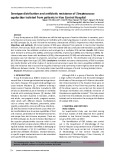
Genitourinary tract
-
Group B streptococcus (GBS) is known as a commensal flora in human gastrointestinal and genitourinary tracts. This study aimed to determine the antibiotic resistance of GBS strains isolated and to determine the serotype distribution of isolated GBS strains.
 5p
5p  vifaye
vifaye
 20-09-2024
20-09-2024
 5
5
 1
1
 Download
Download
-
Harrison's Internal Medicine Chapter 130. Streptococcal and Enterococcal Infections Streptococcal and Enterococcal Infections: Introduction Many varieties of streptococci are found as part of the normal flora colonizing the human respiratory, gastrointestinal, and genitourinary tracts. Several species are important causes of human disease. Group A Streptococcus (GAS, S.
 5p
5p  colgate_colgate
colgate_colgate
 21-12-2010
21-12-2010
 98
98
 5
5
 Download
Download
-
Urinary Tract Infections Urinary tract infections (UTIs) are infrequently caused by S. aureus. In contrast with that of most other urinary pathogens, the presence of S. aureus in the urine suggests hematogenous dissemination. Ascending S. aureus infections occasionally result from instrumentation of the genitourinary tract. Prosthetic Device–Related Infections S. aureus accounts for a large proportion of prosthetic device–related infections.
 6p
6p  colgate_colgate
colgate_colgate
 21-12-2010
21-12-2010
 73
73
 3
3
 Download
Download
-
Nutritional Iron Balance The balance of iron in humans is tightly controlled and designed to conserve iron for reutilization. There is no regulated excretory pathway for iron, and the only mechanisms by which iron is lost from the body are blood loss (via gastrointestinal bleeding, menses, or other forms of bleeding) and the loss of epithelial cells from the skin, gut, and genitourinary tract. Normally, the only route by which iron comes into the body is via absorption from food or from medicinal iron taken orally.
 5p
5p  thanhongan
thanhongan
 07-12-2010
07-12-2010
 61
61
 3
3
 Download
Download
-
Etiology Humoral hypercalcemia of malignancy (HHM) occurs in up to 20% of patients with cancer. HHM is most common in cancers of the lung, head and neck, skin, esophagus, breast, genitourinary tract, and in multiple myeloma and lymphomas. Several distinct humoral causes of HHM occur, most commonly overproduction of PTHrP. In addition to acting as a circulating humoral factor, bone metastases (e.g., breast, multiple myeloma) may produce PTHrP, leading to local osteolysis and hypercalcemia.
 5p
5p  thanhongan
thanhongan
 07-12-2010
07-12-2010
 80
80
 3
3
 Download
Download
-
Patients with leukopenias or leukocyte dysfunction often have delayed inflammatory responses. Therefore, clinical manifestations may be minimal despite overwhelming infection, and unusual infections must always be suspected. Early signs of infection demand prompt, aggressive culturing for microorganisms, use of antibiotics, and surgical drainage of abscesses. Prolonged courses of antibiotics are often required. In patients with CGD, prophylactic antibiotics (trimethoprim-sulfamethoxazole) and antifungals (itraconazole) markedly diminish the frequency of life-threatening infections.
 6p
6p  konheokonmummim
konheokonmummim
 03-12-2010
03-12-2010
 76
76
 5
5
 Download
Download
-
The kidneys comprise only 0.5% of body weight, yet they receive 25% of the cardiac output. Drugs that affect renal function have important roles in cardiac failure and hypertension. Disease of the kidney must be taken into account when prescribing drugs that are eliminated by it. Diuretic drugs: their sites and modes of action, classification, adverse effects and uses in cardiac, hepatic, renal and other conditions. Carbonic anhydrase inhibitors. Cation-exchange resins and their uses. Alteration of urine pH Drugs and the kidney. Adverse effects.
 19p
19p  bigbaby87
bigbaby87
 03-09-2010
03-09-2010
 97
97
 13
13
 Download
Download
CHỦ ĐỀ BẠN MUỐN TÌM



















